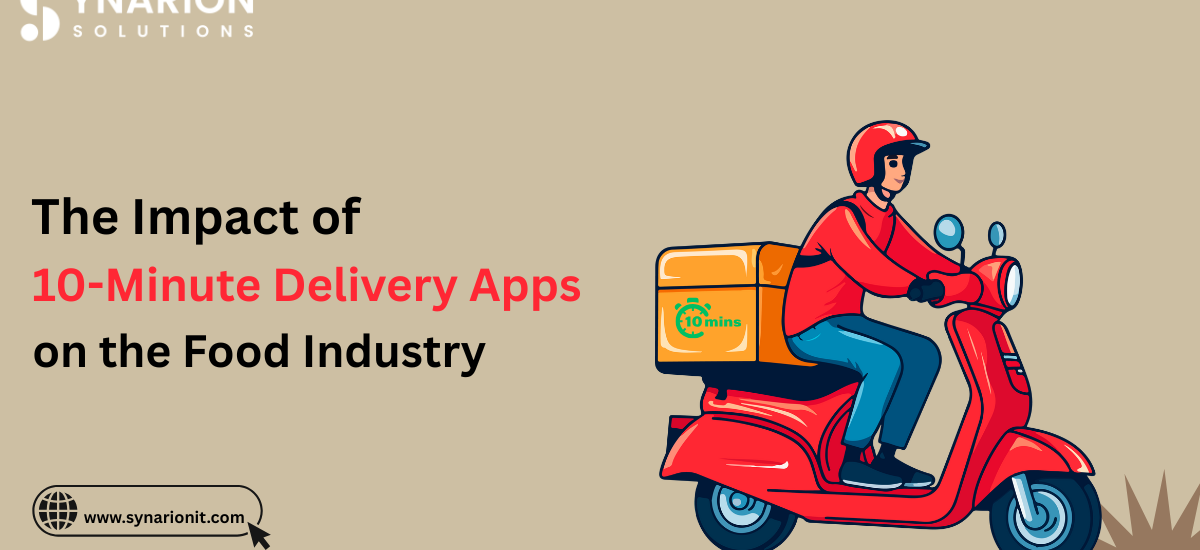The food delivery industry has undergone a massive transformation over the past decade, with on-demand food delivery app development playing a crucial role in reshaping consumer habits. The latest innovation in this sector is the emergence of 10-minute delivery apps, which promise ultra-fast service, revolutionizing the way people order food.
These lightning-fast delivery services are setting new benchmarks in convenience, but they also pose significant challenges for restaurants, delivery platforms, and logistics providers. In this blog, we explore how 10-minute delivery apps are affecting the food industry, the role of food delivery app development services, and what the future holds for this trend.
The Rise of 10-Minute Food Delivery Apps
The idea of getting food delivered in just 10 minutes was once unimaginable. However, with technological advancements, optimized supply chain logistics, and strategic dark kitchen placements, several startups and established food delivery platforms are making this a reality.
Key Players in the 10-Minute Delivery Market
Some of the key players dominating the 10-minute food delivery space include:
- Zepto (India)
- Zomato Instant (India)
- Blinkit (formerly Grofers, India)
- Getir (Europe & USA)
- Gopuff (USA)
These platforms are reshaping customer expectations by delivering meals, groceries, and essentials in record time.
How 10-Minute Delivery Works
For ultra-fast food delivery to function efficiently, companies rely on:
- Hyperlocal Dark Kitchens: These cloud kitchens are strategically placed in high-demand areas to reduce travel time.
- AI & Data Analytics: Advanced algorithms predict demand and pre-stock popular dishes in certain locations.
- Optimized Delivery Routes: AI-driven route optimization ensures riders take the shortest and most efficient paths.
- Fleet Management Technology: Real-time tracking and automated dispatch systems enable quick deliveries.
- Micro Warehouses & Hubs: Mini-warehouses stocked with essentials help fulfill orders faster.
The Impact of 10-Minute Delivery on the Food Industry
1. Changing Consumer Expectations
Customers now demand ultra-fast delivery times, making traditional 30-45 minute deliveries seem slow. This forces restaurants and food delivery platforms to improve operational efficiency.
2. Increased Demand for On-Demand Food Delivery App Development
The success of 10-minute delivery services has accelerated the need for on-demand food delivery app development. Food businesses now seek:
- AI-powered delivery tracking
- Automated order management systems
- Seamless integration with dark kitchens
- Real-time inventory updates
- Rider optimization tools
3. Supply Chain and Logistics Challenges
Maintaining a 10-minute delivery promise requires flawless execution of supply chain logistics. This includes:
- Proper inventory management to avoid stockouts
- Real-time coordination between kitchens, warehouses, and delivery executives
- Addressing rider fatigue and ensuring fair compensation
4. Surge in Quick-Service Restaurants (QSRs)
To adapt to faster deliveries, restaurants are modifying their menus by:
- Offering pre-cooked or semi-prepared meals
- Reducing complex dishes that take longer to prepare
- Introducing automated cooking solutions in cloud kitchens
5. Strain on Delivery Workforce
With extreme delivery speed expectations, delivery partners often face:
- Higher work pressure and increased risk of accidents
- Lower earnings per order due to short delivery distances
- The need for better incentives and fair compensation
6. Environmental Impact
The increase in ultra-fast deliveries leads to:
- More single-use packaging waste
- Higher carbon emissions from increased delivery trips
- A need for sustainable delivery solutions such as electric bikes and eco-friendly packaging
7. Opportunities for Food Delivery App Development Services
To support the growing demand for 10-minute deliveries, food delivery app development services are integrating advanced features such as:
- AI-based demand forecasting
- Automated route planning
- Smart inventory management
- Real-time kitchen coordination tools
- Integration with IoT-enabled kitchens
Future Trends in 10-Minute Food Delivery
The ultra-fast delivery industry is evolving rapidly. Some key future trends include:
1. AI-Powered Automation
- Predictive AI will help restaurants prepare dishes in advance based on demand trends.
- Automated cooking stations will further speed up food preparation.
2. Drone & Robot Deliveries
- Companies like Domino’s and Amazon are already experimenting with drone-based food deliveries.
- Autonomous delivery robots will reduce dependence on human riders.
3. Expansion to New Markets
- Ultra-fast delivery will expand beyond urban centers to smaller cities and towns.
4. Sustainable & Eco-Friendly Practices
- More food delivery companies will adopt biodegradable packaging.
- Electric scooters and bicycles will become the standard for deliveries.
5. Personalized & AI-Driven Recommendations
- AI will suggest quick-to-make dishes based on real-time kitchen capabilities and customer preferences.
Conclusion
The rise of 10-minute delivery apps is revolutionizing the food industry, creating both opportunities and challenges for businesses, delivery personnel, and consumers. With the growing demand for on-demand food delivery app development, companies must invest in advanced food delivery app development services to stay competitive in this fast-paced market.
While the future of ultra-fast food delivery looks promising, businesses must address logistical hurdles, sustainability concerns, and workforce challenges to make this model truly successful.






